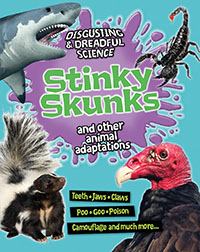| ________________
CM . . . . Volume XXI Number 23 . . . . February 20, 2015
excerpt:
Much to a parent's or a teacher's chagrin, kids seem to be attracted to all things gross, so, with their catchy titles and subject matter, these new additions to the "Disgusting and Dreadful Science" series are sure to appeal. Each of the books is divided into 13 chapters which entice readers with clever and intriguing headings such as "Green, Growing and Deadly!", "Scary Stranglers" and "Teeth, Spit and Slobber". The information within each chapter is not continuous text printed in paragraphs. Rather, there are several stand-alone entries within the chapter, each one with its own intriguing subheading, thus readers can peruse the books in short snippets and choose to read what catches their eyes. Scientific facts are presented along with a few activities and experiments while "Yuck!" text boxes highlight disgusting facts and "Ouch!" boxes discuss the painful effects, for example, of being stung by nettles or having an infected toenail fall off. The information is delivered in a conversational writing style that is infused with humour. Bright and colourful diagrams, cartoon-like drawings and photographs add to the books' visual appeal. A table of contents, a glossary and an index are included. There is also a list of related websites and places to visit in different parts of the world, along with brief descriptions of what information or activities are available. On land, plants outweigh animals by a ratio of 1000 to one. In Killer Plants and Other Green Gunk, readers will learn about unusual plants and some of their seemingly strange survival techniques. From parasitic and stinky plants to meat-eating, drug-producing and venomous plants, this title showcases some rare species, such as the squirting cucumber which explodes with a splat to shoot its slime-covered seeds and the "murderous" manchineel tree whose sap is so deadly that it makes human skin blister at the slightest touch, even affecting people who stand under the tree during a rain or who breathe the smoke when the tree's wood is burning. Readers will find out whether plants have the ability to hear or to communicate with each other. There is also information about the relationship between plants and animals, one example being the green algae that grows on a sloth's fur, effectively camouflaging the sloth in the treetops. Interestingly, the text also mentions the part that "magical" plants play in books such as the Lord of the Rings trilogy and the Harry Potter books. Slimy Spawn and Other Gruesome Life Cycles compares the life cycles of several different animals- humans, rats, marsupials, reptiles, sharks and other fish, crustaceans, amphibians, birds, insects and spiders. What will be rather surprising to readers are the statistics which show that very few eggs or young survive. For instance, out of every 8,000 salmon eggs, only 50 smolts survive and just two make it to adulthood. In the case of sand tiger shark pups, after the pups grow teeth, they eat each other, so, of the 100 in the womb, only one will come out alive. Worse yet, of the two million eggs laid by a female blue crab, only two will develop into an adult crab. Other topics in this title include various animals' parenting skills, worms that live inside other animals, and animals that live on human blood, such as bed bugs and mosquitoes. The title alone of Smelly Farts and Other Body Horrors is bound to generate some interest in the book, along with snickers and laughter. In this title, the gross factor is tempered by explanations of why human bodies behave as they do. Topics covered include how scabs, zits and boils form; the purpose of sweat, snot and earwax; parasites such as mites and head lice; blood, saliva, dental plaque, eye rheum, burping, vomiting, and, of course, waste products—poop and pee. Stinky Skunks and Other Animal Adaptations highlights the physical and behavioral adaptations which enable animals to survive. Readers will be introduced to the terms "survival of the fittest" and "natural selection". Weapons, such as teeth, talons, claws and tusks, can be used for defense and obtaining food while camouflage offers protection and the detachable tails of some lizards allow for a quick getaway from predators. Other topics in this title range from animals that need human blood to survive (mosquitoes and leeches), nocturnal animals and deep sea creatures, to invasive animals (tapeworms) and cannibalistic animals that eat their mates or their own offspring. Highly engaging, educational and fun, these titles are bound to fly off the shelves. Highly Recommended. Gail Hamilton is a former teacher-librarian in Winnipeg, MB. Copyright © the Manitoba Library Association. Reproduction for personal use is permitted only if this copyright notice is maintained. Any other reproduction is prohibited without permission.
Next Review |
Table of Contents for This Issue
- February 20, 2015. |



